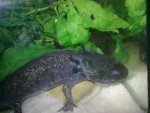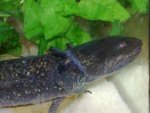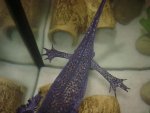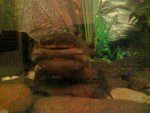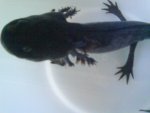Hi all,
The plight of my little one has seemed to take a strange turn. Firstly some background (my apologies for the long post, but I thought I'd give as much info as possible):
I posted on here some time ago about some abnormal growth on her gills and gill loss. Following some sound advice from Rayson and others, I administered 3 days of salt baths and fridging. This did not seem to help, so I bit the bullet and took her to the local herp vet. After a microscopic gill examination, the vet concluded that she had a heap of bacteria growing between her fimbriae and gave me Baytril. I administered the baytil via injection into worms and left her in the fridge for 2 weeks. I then put her back in the tank and continued the antibiotics for an additional week. To be honest, I don't know how effective I was at administering the antibiotics for the first 2 weeks, as I was having great difficulty at injecting the worms. Once I got the hang of it, and following some more sound advice from Rayson, it worked really well.
She seemed fine for 3-4 weeks, but then I noticed the growth again. I took her back to the vet, where he again checked her gills. He said that he wasn't sure about the growth, as it looked like dead skin, but there was still bacteria between her fimbriae. I explained that I wasn't too sure about how effective I was with the injection, so he gave me a fresh vile of Baytril, which I was to continue for another 3 weeks.
In the first week, the growth stopped appearing and she seemed better. However, after that, I noticed her gills were looking a bit smaller and she was floating a lot. I attributed the floating to the fact that she was getting fed 1-2 worms a day, as this is what was required to administer the antibiotics, and therefore, she may have been constipated or gassy. I started to skip a day of feeding/ab here and there, which seemed to help.
For the last week and a half, she has been constantly sitting next to the filter in the corner of the tank. I have an Eheim internal 2010 with a bubbler to aid aeration. I have always been wary of the flow it creates, but it hasn't really been an issue, as she has never exhibited any signs of stress. I have also noticed that when she isn't near the filter, she tends to gulp air a lot, suggesting to me that she is sitting there for the increased o2 content, but that could just be paranoia on my part. She doesn’t gulp air at all when next to the filter, so I'm not sure if there is anything wrong with her gills or not.
I think she has lost weight, even though she is getting fed everyday, and today I noticed that she is shedding and her tail was curled.
I've also noticed a large lump above each of her rear legs. The vet sexed her as female, so I'm guessing they arn't gentials, and they seem too high anyway.
Does anyone have any ideas?? Does she look healthy? (See attached)
Could her gills be shrinking because she has chosen to sit in the most oxygen-rich part of the tank?
I also have a tribe of planaria growing in the tank, could they be contributing?
I am going overseas on Monday for 2 weeks and am leaving my little brother in charge of feeding her, so I was thinking that I'd better get on top of it before I go. I'm going to change 16L of water tomorrow.
Tank parameters:
Ammonia: 0
Nitrite: 0
Nitrate: 20 - 40ish
pH: 6.4
Temp: 20 (it has been the hottest day in Melbourne for about 6 months, so this may be contributing)
Tank is 60cmx30x30 (~50L)
Sand as substrate
Water changes - 8L per week, 16L every 3 weeks or as needed
Any advice would be extremely helpful!!!!!!
Cheers
Paul
The plight of my little one has seemed to take a strange turn. Firstly some background (my apologies for the long post, but I thought I'd give as much info as possible):
I posted on here some time ago about some abnormal growth on her gills and gill loss. Following some sound advice from Rayson and others, I administered 3 days of salt baths and fridging. This did not seem to help, so I bit the bullet and took her to the local herp vet. After a microscopic gill examination, the vet concluded that she had a heap of bacteria growing between her fimbriae and gave me Baytril. I administered the baytil via injection into worms and left her in the fridge for 2 weeks. I then put her back in the tank and continued the antibiotics for an additional week. To be honest, I don't know how effective I was at administering the antibiotics for the first 2 weeks, as I was having great difficulty at injecting the worms. Once I got the hang of it, and following some more sound advice from Rayson, it worked really well.
She seemed fine for 3-4 weeks, but then I noticed the growth again. I took her back to the vet, where he again checked her gills. He said that he wasn't sure about the growth, as it looked like dead skin, but there was still bacteria between her fimbriae. I explained that I wasn't too sure about how effective I was with the injection, so he gave me a fresh vile of Baytril, which I was to continue for another 3 weeks.
In the first week, the growth stopped appearing and she seemed better. However, after that, I noticed her gills were looking a bit smaller and she was floating a lot. I attributed the floating to the fact that she was getting fed 1-2 worms a day, as this is what was required to administer the antibiotics, and therefore, she may have been constipated or gassy. I started to skip a day of feeding/ab here and there, which seemed to help.
For the last week and a half, she has been constantly sitting next to the filter in the corner of the tank. I have an Eheim internal 2010 with a bubbler to aid aeration. I have always been wary of the flow it creates, but it hasn't really been an issue, as she has never exhibited any signs of stress. I have also noticed that when she isn't near the filter, she tends to gulp air a lot, suggesting to me that she is sitting there for the increased o2 content, but that could just be paranoia on my part. She doesn’t gulp air at all when next to the filter, so I'm not sure if there is anything wrong with her gills or not.
I think she has lost weight, even though she is getting fed everyday, and today I noticed that she is shedding and her tail was curled.
I've also noticed a large lump above each of her rear legs. The vet sexed her as female, so I'm guessing they arn't gentials, and they seem too high anyway.
Does anyone have any ideas?? Does she look healthy? (See attached)
Could her gills be shrinking because she has chosen to sit in the most oxygen-rich part of the tank?
I also have a tribe of planaria growing in the tank, could they be contributing?
I am going overseas on Monday for 2 weeks and am leaving my little brother in charge of feeding her, so I was thinking that I'd better get on top of it before I go. I'm going to change 16L of water tomorrow.
Tank parameters:
Ammonia: 0
Nitrite: 0
Nitrate: 20 - 40ish
pH: 6.4
Temp: 20 (it has been the hottest day in Melbourne for about 6 months, so this may be contributing)
Tank is 60cmx30x30 (~50L)
Sand as substrate
Water changes - 8L per week, 16L every 3 weeks or as needed
Any advice would be extremely helpful!!!!!!
Cheers
Paul

